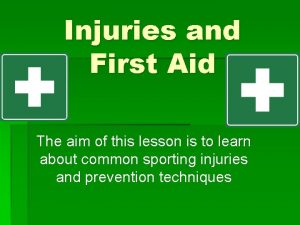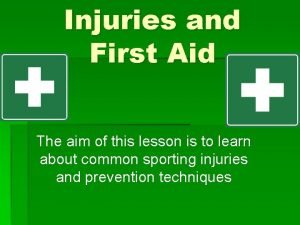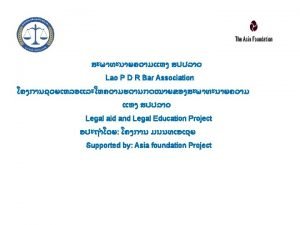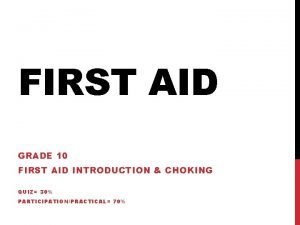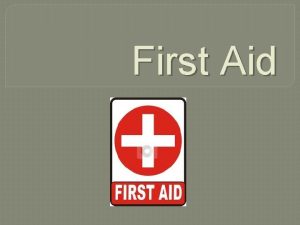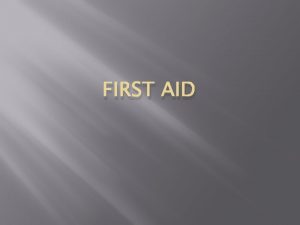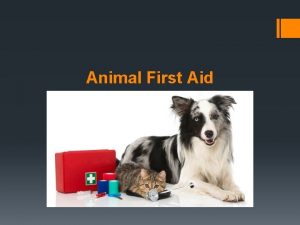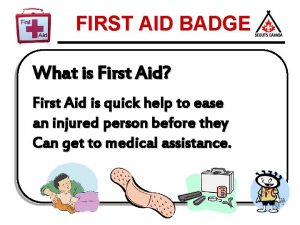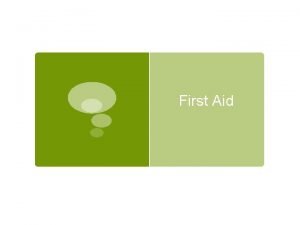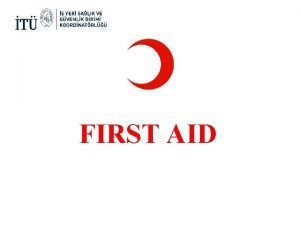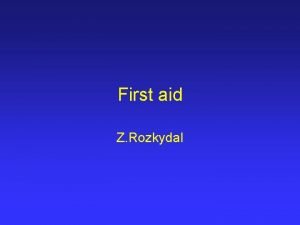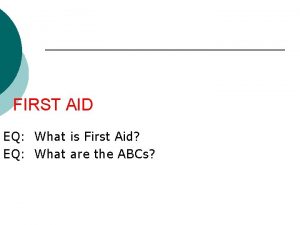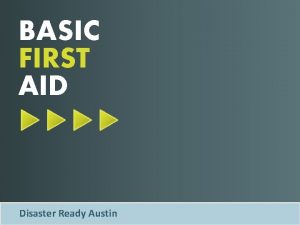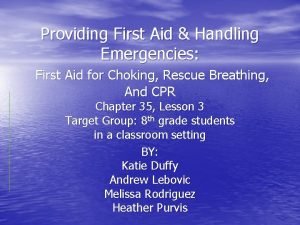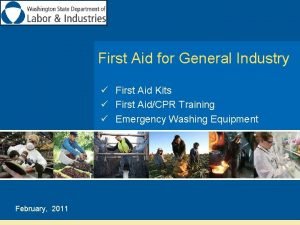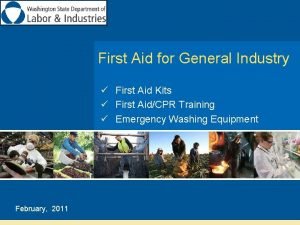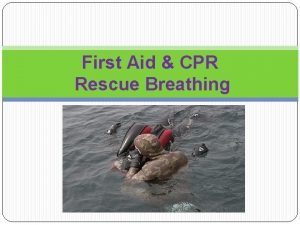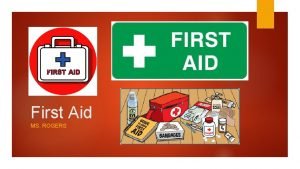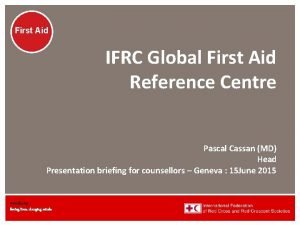First Aid The aim of first aid To










































- Slides: 42

First Aid


The aim of first aid • To Prevent Loss of Life • To Prevent further injury • To Promote recovery

Who is the most important person at an accident? • The person who is lying still and silent • The person loudly screaming for help • The person walking around shocked and dazed • You as the first aider

YOU as the first aider are the most important person Without YOU the other casualties might not survive NEVER put yourself in danger always assess the situation!

The chain of survival Early access to help Early CPR Early Defibrillation Early access to medical care

The Primary Survey D – Danger R – Response A – Airway B – Breathing

Having checked D. R. A. B. GET HELP Either: • Go for help yourself • Send someone else for help Know what information to give the emergency services

Information needed • Where is the problem? • What happened? • How many casualties? • What are their injuries? • When did it all happen? • Who are you?

Leaving your casualty If you have to leave your casualty then you need to put them in the Recovery Position. This ensures that they have a: Safe Open Draining Airway

Cardio Pulmonary Resuscitation CPR is given if the casualty is not breathing 30 chest compressions then 2 rescue breaths (if you feel able) Hands only CPR Repeat until: • The casualty starts breathing for themselves • Help arrives • You are unable to continue

CPR for Children or Drowned Casualties • If the casualty is a child, or you think they have drowned • Give 5 rescue breaths before you start CPR • Then do 30 compressions and 2 breaths as normal • Repeat the 30: 2 until help arrives

Spinal injuries There is always the possibility of spinal injuries where the casualty has: • Fallen from a height • Hit something head first • Been in an accident involving speed • Had a blow to the head, neck or back • Been crushed or had something collapse on them • Multiple injuries • Don’t move the casualty unless you have to

Shock We need oxygenated blood to be pumped around our bodies for it to work properly. Shock can occur when that flow is interrupted by: • Loss of fluids • Inability of the heart to pump blood efficiently Shock can KILL

Signs and symptoms of shock At first some or all of the following: Fast shallow breathing, rapid weak pulse, cyanosis, pale clammy skin, nausea or vomiting, dizziness. As the shock gets worse, lack of oxygen to the brain causes: Deep sighing breathing, confusion, anxiety or aggression, unconsciousness.

Treatment for shock Where possible, treat the cause Call for immediate medical help Lie the casualty down Keep their body temperature normal Elevate legs 15 -30 cm where possible Loosen any tight clothing

Bleeding Three types of bleeding: Arterial Bright red and spurting Venous Dark red and flowing Capillary Oozing from the wound

Treatment for bleeding For bleeding: • Apply direct pressure to the wound • Dress the wound after pressure • Treat for shock For serious bleeding get medical help as soon as possible If something is sticking in the wound, place pressure either side but don’t remove the object as it is forming a plug

Broken bones can be open or closed breaks Open Closed Bone comes through the skin Bone is broken but not breaking the skin Open breaks will need treating for bleeding as well

Signs and symptoms of broken bones Pain Swelling Bruising Deformity Lack of movement May have heard a cracking noise

Treatment for broken bones Immobilise limb Make Casualty comfortable Treat for Shock

Strains, sprains and dislocations Usually caused when the body is stretched or twisted unnaturally Dislocations occur when part of the bone joint jumps out of place

Signs and symptoms Pain Swelling Bruising Lack of movement For a dislocation there may be deformity of the joint The only way to distinguish between a strain / sprain or fracture may be with an X-Ray

Treatment for strains and sprains R – Rest I – Ice C – Compression E – Elevation

Burns and scalds Burns – dry heat Friction Fire Hot metal Sun Scalds – wet heat Hot Water Steam Hot Food

Signs and symptoms Pain Redness Swelling Blistering Loss of skin

Treatment is the same for both: • Cool the area immediately for at least 10 minutes, preferably under running water • Remove jewellery and loose clothing • Wrap with cling film or burns dressing if available • Keep cool • Treat for shock • Medical treatment if size of burn is more than the palm of the Casualty’s hand or if deep

Blisters are a friction burn to the skin: • Remove the source of friction by applying plasters or a dressing at the first sign of any rubbing or pain • Don’t burst a blister • Apply a blister plaster to the blister and make sure the area is clean and dry • Treat blisters before they form – not afterwards

Choking When a foreign body obstructs the airway: • Ask Casualty to cough • Give 5 Strong Backslaps • Give 5 Abdominal Thrusts Repeat Be prepared to do CPR if Casualty stops breathing

Heat and cold 43 Unconscious, fitting 42 Confused 41 Headache, dizzy, no sweating 40 Stronger than normal pulse, flushed dry skin 39 Cramps, pale sweaty skin, nausea 38 37 Normal body temperature 36 35 Shivering 34 Fatigue, slurred speech, unsteady on feet 33 Shivering stops, very slow weak pulse 32 Drowsy, lack of response 31 Unconscious

Treatment for hypothermia Where possible remove wet, cold clothing and replace with dry Give warm (not hot) drinks and food Cover the extremities (head, hands, feet) Insulate the casualty from the ground Get into shelter, (tent or survival bags) Huddle together to share body heat If condition is serious get medical help

Treatment for hyperthermia Help the casualty to cool down Protect them from the sun Remove excess clothing If possible give plenty of water slowly sipped If serious, try cooling casualty with cloths soaked in water, or sponging them with water and fanning them to help the water evaporate

Head injuries Concussion The skull has been shaken and the brain has been bounced around inside the skull Might lead to pale clammy skin, unconsciousness, headache, rapid weak pulse, possible nausea Normal pupils reacting to light Compression The brain is under pressure because there is bleeding or swelling inside the skull Might lead to Intense headache, flushed dry skin, slow strong pulse, responsiveness decreases Pupils may be dilated or unequal

Head injuries Fractured skull: Damage to the actual skull and bone Casualty may also be suffering from concussion or compression of the skull Bleeding, bruising or swelling on the scalp or face Bloodshot eyes Any fluid, including blood, coming from an ear or the nose Pain on being touched

Heart attack A disruption to the normal pumping of the heart, may be caused by: Blood clot Narrowing of the arteries Disruption to the electrical signal to the heart

Signs and symptoms Vice like pain in chest area, can possibly also be felt in left arm, neck, shoulders or back Pale grey colour, may sweat Pulse, not normal usually more rapid Shortness of breath Dizziness Nausea Sense of impending doom

Treatment for heart attacks Call for immediate medical assistance Sit the casualty down and make them comfortable Reassure the casualty Check if they have any medication to take Be prepared to start CPR Administer 300 mg of Aspirin (if not allergic)

Anaphylaxis A massive over-reaction of the body’s immune system to some external factor. • Nuts • Penicillin or other drugs • Sea food • Bee or Wasp stings May occur very quickly and may impair breathing, cause a rash or blotches, cause nausea or vomiting. Casualty will be very frightened.

Treatment for anaphylaxis Immediate medical assistance is required Reassure casualty Check if they have an EPI pen they can inject Be prepared to resuscitate if necessary

Asthma A breathing problem caused usually by a trigger. • Allergic reaction to pets or fur • Exercise • Stress • Pollen • Other specific trigger Casualty has difficulty breathing and gasps for air Noticeable wheezing with breathing

Treatment Sit the casualty down in a W position Help them to take their inhaler, one puff every minute for 5 minutes If no improvement within five minutes call for an ambulance Keep the casualty safe, reassured and warm

Bites and stings • Remove a sting by pushing it out with a flat piece of plastic or card (don’t use tweezers) • Remove ticks using the proper tick removal tool • Wipe the area with antiseptic wipes • Be aware of any swellings or rashes that might occur and seek treatment where necessary.
 First aid merit badge first aid kit
First aid merit badge first aid kit First aid aim
First aid aim The aim of first aid is to
The aim of first aid is to Legal aid meaning aim and objective
Legal aid meaning aim and objective Objectives of first aid
Objectives of first aid Green hill park medical centre
Green hill park medical centre Các châu lục và đại dương trên thế giới
Các châu lục và đại dương trên thế giới Hươu thường đẻ mỗi lứa mấy con
Hươu thường đẻ mỗi lứa mấy con Từ ngữ thể hiện lòng nhân hậu
Từ ngữ thể hiện lòng nhân hậu Thế nào là hệ số cao nhất
Thế nào là hệ số cao nhất Diễn thế sinh thái là
Diễn thế sinh thái là Vẽ hình chiếu vuông góc của vật thể sau
Vẽ hình chiếu vuông góc của vật thể sau 101012 bằng
101012 bằng Lời thề hippocrates
Lời thề hippocrates Glasgow thang điểm
Glasgow thang điểm đại từ thay thế
đại từ thay thế Quá trình desamine hóa có thể tạo ra
Quá trình desamine hóa có thể tạo ra Công của trọng lực
Công của trọng lực Khi nào hổ mẹ dạy hổ con săn mồi
Khi nào hổ mẹ dạy hổ con săn mồi Thế nào là mạng điện lắp đặt kiểu nổi
Thế nào là mạng điện lắp đặt kiểu nổi Dạng đột biến một nhiễm là
Dạng đột biến một nhiễm là Thế nào là sự mỏi cơ
Thế nào là sự mỏi cơ Bổ thể
Bổ thể Vẽ hình chiếu đứng bằng cạnh của vật thể
Vẽ hình chiếu đứng bằng cạnh của vật thể độ dài liên kết
độ dài liên kết Thiếu nhi thế giới liên hoan
Thiếu nhi thế giới liên hoan Hát lên người ơi
Hát lên người ơi điện thế nghỉ
điện thế nghỉ Một số thể thơ truyền thống
Một số thể thơ truyền thống Trời xanh đây là của chúng ta thể thơ
Trời xanh đây là của chúng ta thể thơ Số nguyên tố là gì
Số nguyên tố là gì đặc điểm cơ thể của người tối cổ
đặc điểm cơ thể của người tối cổ Tỉ lệ cơ thể trẻ em
Tỉ lệ cơ thể trẻ em Tia chieu sa te
Tia chieu sa te Các châu lục và đại dương trên thế giới
Các châu lục và đại dương trên thế giới ưu thế lai là gì
ưu thế lai là gì Sơ đồ cơ thể người
Sơ đồ cơ thể người Tư thế ngồi viết
Tư thế ngồi viết Kể tên các môn thể thao
Kể tên các môn thể thao Hát kết hợp bộ gõ cơ thể
Hát kết hợp bộ gõ cơ thể Cái miệng nó xinh thế chỉ nói điều hay thôi
Cái miệng nó xinh thế chỉ nói điều hay thôi Mật thư anh em như thể tay chân
Mật thư anh em như thể tay chân

